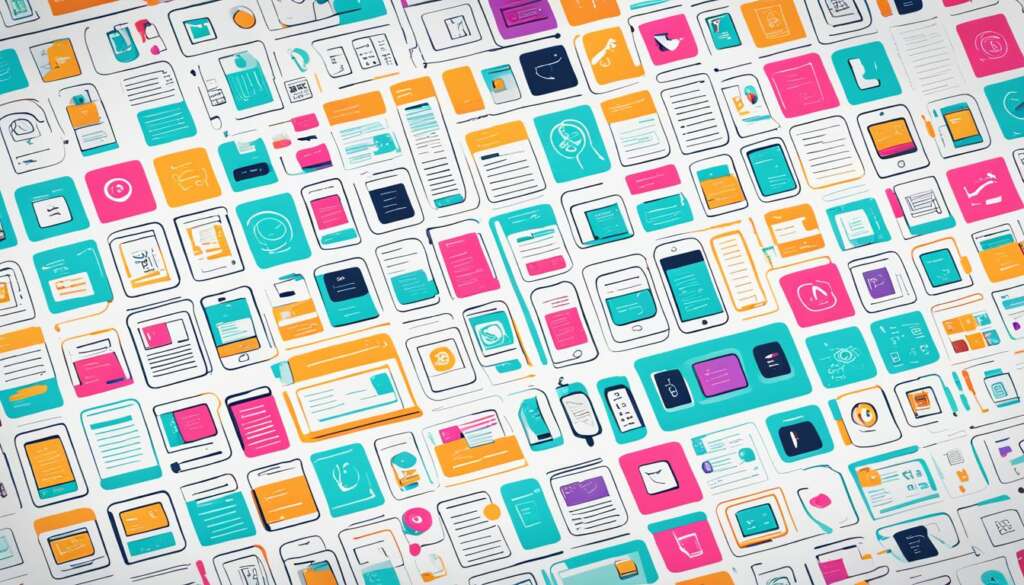Table of Contents
Web design plays a crucial role in creating visually appealing and user-friendly websites. It is reported that 75% of website credibility is due to its design. In this section, we will explore the top responsive design tools that web developers can use to create seamless websites for all devices. These tools include website builders, web design tools with code editors, design tools for making prototypes, and more.
Responsive design is vital for ensuring that websites adapt to different screen sizes and devices, providing users with an optimal browsing experience. With the help of these resources, web developers can efficiently design and develop websites that are visually appealing, easy to navigate, and accessible from any device.
Top Website Builders for Responsive Design
When it comes to creating responsive websites without any coding experience, website builders are the go-to tools for web developers. These platforms provide an efficient and user-friendly way to design visually appealing and functional websites. Here are some of the top website builders that are highly recommended for responsive design:
- Wix
- HubSpot
- Squarespace
- Shopify
- WordPress
These website builders offer a variety of features and functionalities to help web developers create responsive websites that seamlessly adapt to different devices and screen sizes. Let’s explore some key features provided by these platforms:
| Website Builder | Features |
|---|---|
| Wix | Drag-and-drop functionality, customizable templates, SEO tools, app market, full design control. |
| HubSpot | Responsive themes, content staging, SEO recommendations, lead capture forms and pop-ups. |
| Squarespace | Flexible design options, integrated e-commerce, blogging tools, professional templates. |
| Shopify | E-commerce focused, mobile-friendly themes, product management, secure payment gateways. |
| WordPress | Extensive plugin options, customizable themes, SEO capabilities, blogging platform. |
With these website builders, web developers can leverage features such as drag-and-drop functionality, customizable templates, and SEO tools to create stunning and responsive websites. Additionally, the platforms provide user-friendly interfaces that make the web design process intuitive and efficient.
By utilizing these website builders, web developers can save time and effort in building responsive websites while still achieving visually appealing designs and optimal user experiences. Whether you’re a beginner or an experienced web developer, these website builders offer the tools and resources you need to create stunning websites without the need for extensive coding knowledge.
When it comes to responsive design, these top website builders have proven their effectiveness in delivering outstanding results without compromising on functionality and design aesthetics. By harnessing the power of website builders, web developers can create websites that captivate users across devices and enhance the overall online presence of businesses and brands.
Web Design Tools with Code Editors and Visual Design Software
When it comes to web design, having the right tools can make all the difference. Adobe Dreamweaver, Figma, Nova, and Google Web Designer are top-notch web design tools that combine powerful code editors with intuitive visual design software. These tools offer a comprehensive solution for web developers, allowing them to create stunning and responsive websites from scratch or using pre-designed templates.
One of the key advantages of these web design tools is their ability to provide real-time previews, helping developers visualize their designs as they code. This feature allows for rapid iteration and ensures that the final result is exactly as intended. Additionally, these tools offer code hints and autocompletion features, streamlining the coding process and reducing errors.
GitHub support is another noteworthy feature of these tools, enabling seamless collaboration and version control. This makes it easy for multiple developers to work together on a project, ensuring consistency and efficiency in the design process.
Furthermore, web developers can take advantage of various customization options offered by these tools. From selecting fonts to modifying color schemes, these design software provide flexibility to create unique and visually appealing websites. Whether you are an experienced developer or a beginner in the field of web design, these tools cater to different skill levels and offer a range of features to meet your specific needs.
Let’s take a closer look at each of these web design tools:
-
Adobe Dreamweaver
Adobe Dreamweaver is a widely-used web design tool that offers a powerful code editor and visual design interface. It supports both HTML and CSS, making it suitable for creating responsive websites. With Dreamweaver, developers can take advantage of its extensive library of code snippets and templates, significantly speeding up the development process.
-
Figma
Figma is a cloud-based design tool that allows for collaborative design and prototyping. It offers a user-friendly interface and advanced design features, making it ideal for both individual designers and design teams. Figma also integrates with popular design systems and version control platforms, providing a seamless design workflow.
-
Nova
Nova is a code editor specifically tailored for web developers. It offers a clean and intuitive interface, along with powerful customization options. Nova supports popular programming languages like HTML, CSS, JavaScript, and PHP, providing a versatile environment for coding and designing websites.
-
Google Web Designer
Google Web Designer is a free design tool that allows for creating interactive HTML5-based designs and motion graphics. It offers a visual design interface, drag-and-drop functionality, and a robust animation timeline. With Google Web Designer, developers can build engaging and interactive content that is optimized for multiple devices.
These web design tools with code editors and visual design software empower web developers to bring their creative visions to life. By leveraging the features and capabilities of these tools, developers can efficiently design and build stunning websites that deliver an exceptional user experience.
Example Table:
| Web Design Tool | Key Features |
|---|---|
| Adobe Dreamweaver | Powerful code editor, extensive library of templates and code snippets, HTML and CSS support |
| Figma | Cloud-based design tool, collaborative design and prototyping, integration with design systems |
| Nova | Tailored code editor for web developers, clean and intuitive interface, supports popular programming languages |
| Google Web Designer | Free design tool, visual design interface, drag-and-drop functionality, animation timeline |
Image: Visual representation of web design tools with code editors and visual design software.
Design Tools for Prototyping
When it comes to creating interactive and dynamic prototypes for websites, web developers rely on specialized design tools. Two popular options in this category are InVision Studio and Adobe XD.
InVision Studio offers a comprehensive set of features that simplify the prototyping process. With its collaboration capabilities, web developers can seamlessly work together with stakeholders, fostering effective communication and feedback. The API plugin support adds further flexibility and customization options to the prototyping workflow. Additionally, InVision Studio’s auto layout feature streamlines the design process by automatically adjusting elements based on screen size, saving developers valuable time. The extensive template libraries provide a wealth of pre-designed options, empowering developers to bring their ideas to life with ease.
Adobe XD, another leading design tool for prototyping, combines a host of functionalities tailored to web developers’ needs. Collaborative capabilities enable seamless teamwork and real-time feedback from stakeholders. Auto layout features ensure the design’s responsiveness, adapting to different devices and screen sizes. The availability of API plugins enhances customization possibilities, enabling developers to create unique and interactive prototypes. With Adobe XD’s intuitive interface, web developers can effortlessly create sophisticated and visually appealing prototypes, bringing their design ideas to the forefront.
Both InVision Studio and Adobe XD provide web developers with the necessary tools to create prototypes that effectively convey their design vision and gather valuable input from stakeholders. The ability to interact with prototypes enhances the user experience and allows for informed design decisions to be made.
Key Features of Design Tools for Prototyping:
| Design Tool | Key Features |
|---|---|
| InVision Studio |
|
| Adobe XD |
|
Graphic Design Tools for Web Developers
When it comes to creating visually appealing visual elements for websites, graphic design tools play a crucial role. Two popular tools that cater to the needs of web developers are Canva and Boxy SVG. These tools provide a range of features and functionalities to enhance the design process and contribute to an engaging user experience.
Canva
Canva is a versatile graphic design tool that offers customizable templates and a drag-and-drop feature, making it easy for web developers to create stunning designs. With its vast library of pre-designed templates, Canva provides endless possibilities for creating visually appealing elements, such as banners, logos, social media graphics, and more. Whether you’re a seasoned developer or a beginner, Canva’s intuitive interface allows you to bring your design ideas to life without any hassle.
Boxy SVG
Boxy SVG is a powerful design tool that allows web developers to work directly with vector graphics in their browsers. With its robust set of editing tools and features, developers can manipulate and modify graphics with precision and ease. Whether you need to create icons, illustrations, or other graphical elements, Boxy SVG offers a seamless experience for designing scalable vector graphics. Its user-friendly interface and real-time preview make it a valuable asset for web developers looking to craft visually stunning websites.
“Graphic design tools like Canva and Boxy SVG empower web developers to create visually stunning websites that leave a lasting impression on visitors.”
With Canva and Boxy SVG at your disposal, you have the means to elevate the visual appeal of your websites and deliver an immersive user experience. Whether you’re designing logos, banners, icons, or other graphical elements, these tools provide the flexibility and functionality required to bring your creative vision to life. By incorporating visually appealing visual elements into your websites, you can capture the attention of your audience and create a memorable online presence.
| Features | Canva | Boxy SVG |
|---|---|---|
| Customizable templates | ✅ | ❌ |
| Drag-and-drop functionality | ✅ | ❌ |
| Vector graphic manipulation | ❌ | ✅ |
| User-friendly interface | ✅ | ✅ |
| Real-time preview | ✅ | ✅ |
Conclusion
Responsive design tools are essential for web developers to create visually appealing and functional websites that adapt to different devices and screen sizes. The tools mentioned in this article offer various features and functionalities to facilitate the web design process. Whether it’s website builders, design tools with code editors, or graphic design tools, web developers have a range of options to choose from based on their specific needs and skill levels.
Leveraging these tools can help web developers design websites that enhance user experience and drive success in today’s digital landscape. By utilizing responsive design tools, web developers can ensure that their websites look great on desktops, laptops, tablets, and mobile devices, providing a seamless browsing experience for users. These tools enable web developers to create cohesive and consistent designs across multiple platforms, allowing for easy navigation and intuitive interactions.
In conclusion, responsive design tools are indispensable for web developers looking to create websites that are both visually appealing and highly functional. By harnessing the power of these tools, web developers can build websites that adapt to the ever-changing digital landscape, ensuring that their designs are accessible to a wide range of users. So, whether you’re a seasoned web developer or just starting out, incorporating responsive design tools into your workflow is crucial for success in the modern web design industry.
FAQ
What are responsive design tools?
Responsive design tools are software or platforms that web developers use to create visually appealing and user-friendly websites that adapt to different devices and screen sizes.
Why are responsive design tools important for web developers?
Responsive design tools are essential for web developers because they allow them to create websites that enhance user experience and adapt to the diverse range of devices and screen sizes in today’s digital landscape.
What are the top website builders for responsive design?
Some of the top website builders for responsive design include Wix, HubSpot, Squarespace, Shopify, and WordPress. These platforms provide user-friendly interfaces and customizable templates to help web developers design visually appealing and functional websites without any coding experience.
What are web design tools with code editors and visual design software?
Web design tools with code editors and visual design software combine the ability to write code with visual design capabilities. Examples of such tools include Adobe Dreamweaver, Figma, Nova, and Google Web Designer.
What are design tools for prototyping?
Design tools for prototyping enable web developers to create interactive and dynamic prototypes for their websites. InVision Studio and Adobe XD are popular examples of design tools that specialize in prototyping.
What are graphic design tools for web developers?
Graphic design tools for web developers, such as Canva and Boxy SVG, provide the ability to create visually appealing visual elements for websites. These tools enhance the visual appeal of websites and contribute to an engaging user experience.
How can responsive design tools benefit web developers?
Responsive design tools offer various features and functionalities that facilitate the web design process, allowing web developers to create visually appealing and functional websites. These tools cater to different skill levels and specific needs, helping web developers achieve success in today’s digital landscape.
Where can I find more resources on responsive design tools for web developers?
There are numerous online platforms, blogs, and forums dedicated to sharing resources and information about responsive design tools for web developers. Some popular sources include web design communities, technology websites, and industry-specific publications.













